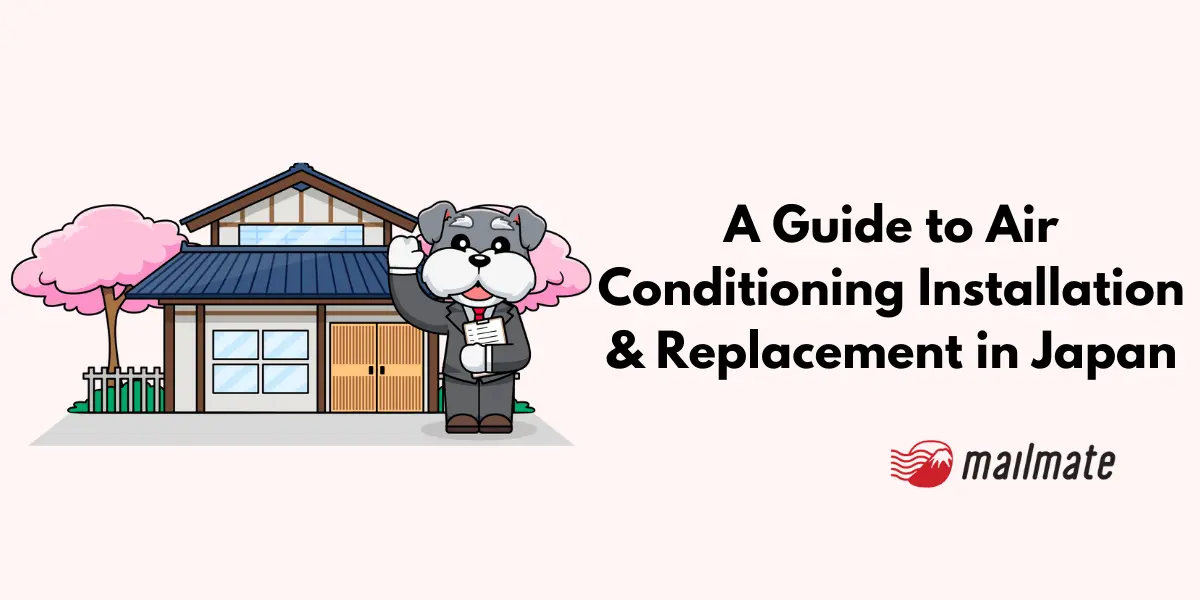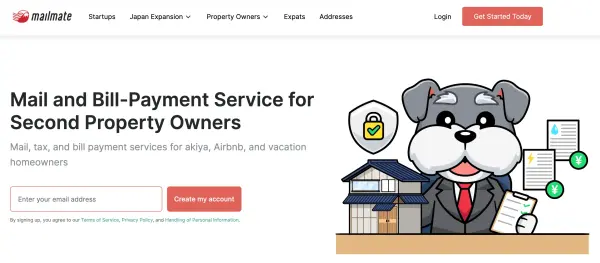A Guide to Air Conditioning Installation & Replacement in Japan

Wondering what heating options are available to help you get through Japanese winters and humid summers?
Thinking of purchasing an air conditioning system for your home or apartment in Japan?
Interested to know how much the whole process will be and how to get it done?
Today, we'll cover what you need to know to install a new AC unit, what features to consider, price points, and more.
Let's go.
How Japanese AC units are different from central air conditioning systems
Before we go any further, let's clear the air on one thing: Japanese heating and cooling systems are different from the HVAC systems in the US and other places.
Unless you live in Hokkaido or specifically contract to install a central AC system, most Japanese homes and apartments will be heated and cooled through an air conditioning unit.
Japanese air conditioning units typically consist of two parts: an indoor unit, which is attached to an interior wall, and an outdoor unit, the condenser, which is either mounted to the exterior of your house or sits on the ground level.
How to choose the right air conditioning unit
If your apartment is small, you may only need to purchase 1 unit.
However, if you're trying to heat a whole house, you may want to place a unit in each room you'll use.
Here are some questions to consider when selecting your new air conditioner.
What size room am I trying to heat?
The first thing you’ll notice when shopping for a Japanese air conditioning unit is that AC manufacturers will market units based on Japanese room size, aka tatami size.
First, determine the room size you're trying to heat, translate that into tatami mats, and then look for an air conditioner that can heat that area.
6 tatami mats (9.9174 sq. meters)
8 tatami mats (13.2232 sq. meters)
10 tatami mats (16.529 sq. meters)
12 tatami mats (19.8348 sq. meters)
14 tatami mats (23.1406 sq. meters)
18 tatami mats (29.7522 sq. meters)
20 tatami mats (33.058 sq. meters)
23 tatami mats (38.0167 sq. meters)
26 tatami mats (42.9754 sq. meters)
Room size calculator and recommended AC capacity chart
Room Size (sq. meters) |
Tatami Mats |
Recommended AC Capacity |
9.9 m² |
6 tatami |
2.2kW |
13.2 m² |
8 tatami |
2.5kW |
16.5 m² |
10 tatami |
2.8kW |
19.8 m² |
12 tatami |
3.6kW |
23.1 m² |
14 tatami |
4.0kW |
29.8 m² |
18 tatami |
5.6kW |
33.1 m² |
20 tatami |
6.3kW |
Pro Tip: Choose a unit slightly larger than your room size for better efficiency and faster heating/cooling.
Decision tree: which AC is right for you?
Step 1: Room Usage
Primary living space → Go larger (14+ tatami capacity)
Bedroom only → Standard size (10-12 tatami)
Secondary room → Smaller unit (6-8 tatami)
Step 2: Functions Needed
Year-round use → Heat pump (heating + cooling)
Summer only → Cooling-only model (cheaper)
High humidity area → Look for advanced dehumidifying
Step 3: Power Requirements
Small units (≤3.6kW) → 100V outlet OK
Large units (≥4.0kW) → 200V outlet required
Step 4: Special Features
Smart home integration → Wi-Fi enabled models
Air quality concerns → Units with air purification
Quiet operation → Inverter technology models
Do I need heating and cooling or just one or the other?
Many Japanese ACs can both heat and cool your house.
However, some only have one function.
So, if you're in the market for both functions, ensure the AC unit you're considering can provide both.
What voltage outlets are available in my house/apartment?
The standard electricity outlet in a Japanese house or apartment is 100 volts.
Some AC units are OK with a 100-volt outlet. However, the more powerful air conditioning units will require a 200-volt outlet.
Before purchasing an AC unit, check its voltage requirements.
If you purchase a new air conditioner that requires 200 volts, you will need an electrician / or the AC installation team to help with rewiring.
How much do Japanese AC units cost?
The average price when looking at the top 10 most highly rated air conditioning units is 64,906 yen on Kakaku.com
Generally, air conditioners that heat small areas will be cheaper than those that heat larger areas.
AC units that provide heating and cooling systems will cost more than AC systems with only one heating or cooling feature.
To start price browsing for AC units, check out the following:
See also: How To Set Up Utilities For The First Time in Japan And More
Total project cost breakdown for air conditioning installation and replacement
Here are some example scenarios of how much you can expect to pay to purchase a new air conditioner plus get it installed.
Scenario 1: 12-Tatami Living Room (Standard Installation)
AC Unit: ¥65,000
Standard Installation: ¥14,300
Total: ¥79,300
Scenario 2: 14-Tatami Room, Second Floor (Non-Standard)
AC Unit: ¥85,000
Standard Installation: ¥19,800
Extra piping (2m): ¥5,000
Second floor surcharge: ¥15,000
Total: ¥124,800
Scenario 3: First AC Installation (New Construction)
AC Unit: ¥70,000
Standard Installation: ¥14,300
Wall drilling: ¥8,000
200V outlet installation: ¥12,000
Total: ¥104,300
What to know about the air conditioning installation process
You have purchased or are about to purchase an AC unit, and now you are wondering how it will be installed.
Many sites will include the cost of installation within the price of the AC unit—but with many caveats.
A standard AC installation is straightforward, particularly if you're replacing an AC, as you don't need to cut a new hole for the AC pipes.
But if this is a new installation, or you want to install an aircon on the second floor of your house, or the room you want to install an aircon in doesn't have a wall connected to the outside of your house, then these will likely fall outside of the "free installation" requirements.
Most AC product pages will have an explanation of what will fall under a "free installation" so be sure to read the fine print.
Standard installation for air conditioning system
Some sites charge a "standard installation fee" and they'll list what type of installation they're willing to do for a certain price.
For example, BicCamera, a well-known Japanese electronics store, provides an AC installation service for "standard installation" at the following prices:
Air conditioner installation cost for standard installation |
Installation fee |
Air conditioners with a cooling capacity of 3.6kw or less (for rooms of 6 to 12 tatami mats) |
14,300 yen |
Air conditioner with cooling capacity of 3.7kw or more (for large rooms of 14 tatami mats or more) |
19,800 yen |
Window Air Conditioner |
7,700 yen |
As far as what BicCamera considers "standard installation":
Installation of piping of 4m or less in length. *If the air conditioning indoor unit and the piping hole are separated, an insulated drain hose (starting from 1,980 yen per meter) will be used as an additional paid installation.
Connecting to an existing earth wire
Installation in walls with through-holes
Installation of piping and connecting wires up to 4m in length (tape-wrapped finish)
Vacuuming
Installation of the outdoor unit on flat ground or on a balcony (including plastic blocks)
Non-standard air conditioning installation
However, Biccamera's aircon installation service guide then goes on to describe the situations that would fall outside of the "standard installation":
If the piping length needs to be 4m or more, or if the outdoor unit is to be installed on the roof or other work that does not fall under the standard installation work, an additional fee will be charged.
When the material of the wall on which the air conditioner (indoor unit) is installed is special
When the outdoor unit is installed other than on flat ground or on a balcony
When the indoor unit and outdoor unit are on different floors/When the piping is 4m or longer
In special cases where there is no hole for the piping
When attaching a cover to a piping
If there is no dedicated outlet for the air conditioner or if the power source, electrical capacity, or plug shape is different
When installing an air conditioner with smartphone connectivity
If your room is on the second floor or higher and there is no elevator
Here's an image that shows the different non-standard places an outdoor unit can be placed all but one of the installations will likely require additional fees from any installation provider.

The AC installation in the above image that falls under "standard installation" would be the AC unit in the bottom left-hand corner. If you want to install a unit in any of the numbered locations in the image below, expect to pay more.
If you are purchasing an air conditioner replacement, some services will remove your old AC unit and recycle it for free, while others will charge you. So keep that in mind.
Pre-installation checklist
Confirm room measurements and tatami size
Check electrical outlet voltage (100V or 200V)
Clear installation area of furniture
Verify outdoor unit placement location
Confirm installation appointment time
Prepare payment method
Take photos of current setup (if replacing)
Questions to ask your installer
Is my wall suitable for mounting?
Where will the outdoor unit be placed?
How long will installation take?
What warranty is included?
When should I schedule first maintenance?
Japanese vocabulary for HVAC systems
Here are some good-to-know Japanese terms to help you as you shop around for your new HVAC system:
General AC vocabulary
エアコン (eakon) – Air conditioner (short for air conditioning)
冷房 (reibou) – Cooling (air conditioning mode)
暖房 (danbou) – Heating (air conditioning mode)
除湿 (joshitsu) – Dehumidifying (air conditioning mode)
加湿 (kashitsu) – Humidifying
空気清浄機能 (kuuki seijou kinou) – Air purification function
リモコン (rimokon) – Remote control
フィルター (firutā) – Filter
室外機 (shitsugaiki) – Outdoor unit (of the air conditioner)
室内機 (shitsunaiki) – Indoor unit (of the air conditioner)
AC installation vocabulary
取り付け (toritsuke) – Installation
工事 (kouji) – Construction or installation work
工事費用 (kouji hiyou) – Installation cost
配線 (haisen) – Wiring
配管 (haikan) – Piping
壁掛け式 (kabekake-shiki) – Wall-mounted type
設置場所 (secchi basho) – Installation location
下見 (shitami) – Pre-installation inspection
配電盤 (haidenban) – Electrical panel
ドレンホース (doren hōsu) – Drain hose
AC troubleshooting and maintenance
メンテナンス (mentenansu) – Maintenance
掃除 (souji) – Cleaning
水漏れ (mizumore) – Water leakage
異音 (ion) – Strange noise
故障 (koshou) – Malfunction or breakdown
修理 (shuuri) – Repair
点検 (tenken) – Inspection
AC-related Japanese phrases
エアコンを設置したいです。 (Eakon o secchi shitai desu.) – I want to install an air conditioner.
工事の見積もりをお願いします。 (Kouji no mitsumori o onegaishimasu.) – Please provide an estimate for the installation work.
このエアコンはどのくらいの部屋に適していますか? (Kono eakon wa dono kurai no heya ni tekishiteimasu ka?) – What size room is this air conditioner suitable for?
工事にどれくらい時間がかかりますか? (Kouji ni dorekurai jikan ga kakarimasu ka?) – How long will the installation take?
保証はありますか? (Hoshou wa arimasu ka?) – Is there a warranty?
Frequently asked questions
What does standard AC installation include?
Standard AC installation in Japan covers the installation of a unit in a non-complex location on your house. For example, putting in an AC system on the first floor of your house where the pipe does not need to travel far to be connected to the outside AC unit would be considered standard by many AC installation teams. However, non-standard installation will often cover cases such as if you wish to place an AC unit on the second floor of your house, which will require a longer than usual pipe to reach the outside unit on the ground floor of your house or require that the outside unit be mounted to the wall of your house.
How much does it cost to install a new aircon in Japan?
Standard installation fees are often included in the price of the air conditioning unit. If you require non-standard installation for 1 AC unit, the cost can range from as low as 10,000 yen to as high as 50,000 to 70,000 yen.
What's the difference between 100V and 200V AC units?
100V units are suitable for smaller rooms (up to 12 tatami) and plug into standard outlets. 200V units are more powerful, suitable for larger spaces, but require special outlets and electrical work.
How long do Japanese AC units last?
Quality units from major brands typically last 10-15 years with proper maintenance. Budget models may last 8-10 years. Regular maintenance significantly extends lifespan.
Can I use my AC for heating in winter?
es, most Japanese AC units are heat pumps that provide both heating and cooling. They're very efficient for heating and are the primary heating method in most Japanese homes.
Why is my AC leaking water?
Water leaks usually indicate a clogged drain hose or improper installation angle. Check the drain hose first, and call a professional if the problem persists.
My electricity bill is very high. Could it be my AC?
AC units can account for 30-50% of electricity costs. High bills may indicate inefficient operation, poor insulation, or an aging unit. Consider professional maintenance or replacement if your unit is over 10 years old.
In closing
Now you know the basis for getting an air conditioning replacement or installing a new air conditioning system in Japan.
Don't speak Japanese? Just purchased a second home in Japan?
Consider using MailMate's property management services to help you stay on top of your home away from home.
MailMate can help you pay taxes on your property and serve as your domestic point of contact and energy liaison, helping you connect your property to water, gas, electricity, and more.

The service includes the following features:
Tax representative for annual real estate tax payments
Domestic point of contact for authorities (required by law)
Bill pay support for property tax payments
Tax notifications with English summaries
A virtual mailbox to receive the mail that arrives at your Japanese property
Manage important property documents and notifications in one place
Other services MailMate offers include utility and Internet setup of your Japanese property!
Founded in 2019, MailMate has simplified property ownership for foreigners living abroad and is an increasingly popular option recommended by users and well-known industry figures.

Additionally, if you use MailMate's tax representative service for property owners, MailMate will take care of filing the tax representative form with the relevant tax office on your behalf.
Navigate Japan's tax system with an experienced tax representative service tailored for foreign property owners!
Spending too long figuring out your Japanese mail?
Virtual mail + translation services start at 3800 per month. 30-day money-back guarantee.

